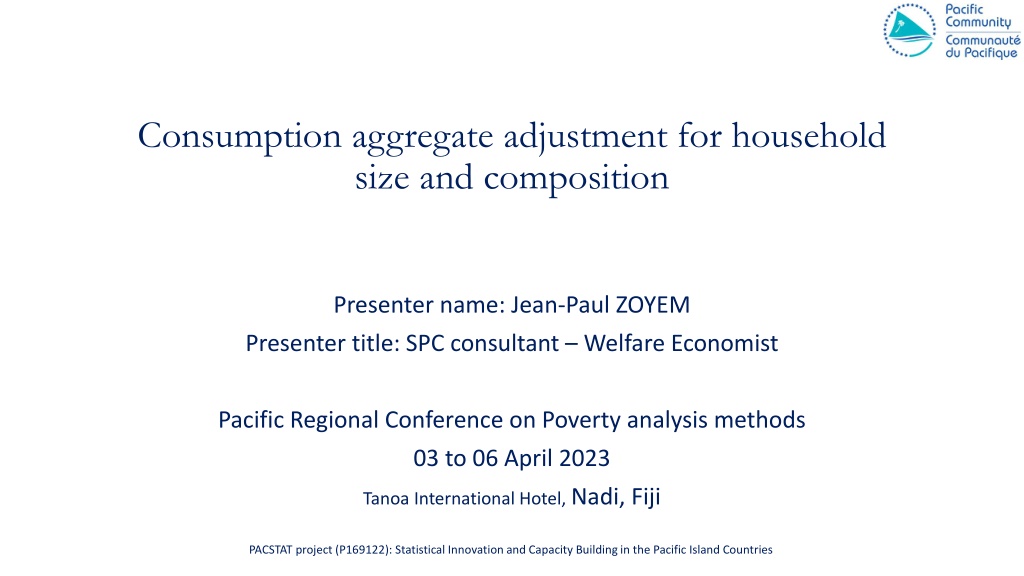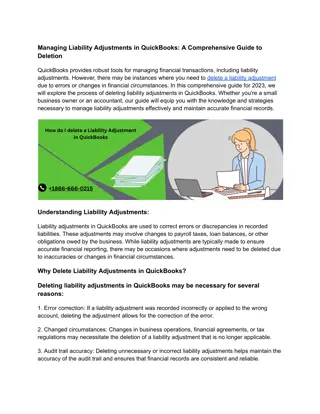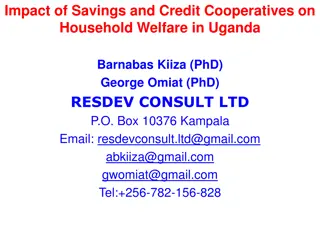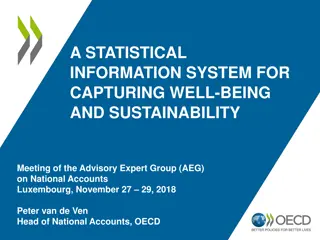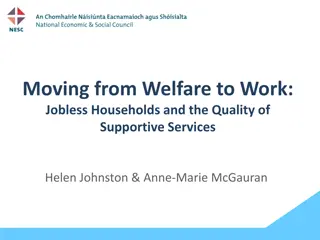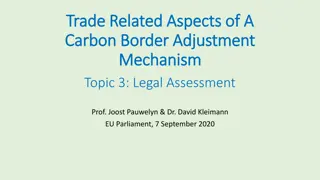Household Consumption Adjustment for Welfare Analysis
Indicator of household size and composition plays a crucial role in measuring household welfare through consumption adjustment. Explore the use of consumption per capita and adult equivalent as measures and understand the limits and benefits of each approach.
Download Presentation

Please find below an Image/Link to download the presentation.
The content on the website is provided AS IS for your information and personal use only. It may not be sold, licensed, or shared on other websites without obtaining consent from the author. Download presentation by click this link. If you encounter any issues during the download, it is possible that the publisher has removed the file from their server.
E N D
Presentation Transcript
Consumption aggregate adjustment for household size and composition Presenter name: Jean-Paul ZOYEM Presenter title: SPC consultant Welfare Economist Pacific Regional Conference on Poverty analysis methods 03 to 06 April 2023 Tanoa International Hotel, Nadi, Fiji PACSTAT project (P169122): Statistical Innovation and Capacity Building in the Pacific Island Countries
Indicator of household size Consumption per capita to measure household welfare Consumption aggregate shows the differing consumption among households. However, it does neither inform on welfare inequality, nor on poverty. It seems obvious that the consumption needs of a household increase with the size. A natural indicator of welfare would be the ratio of the total consumption aggregate to household size. The natural indicator of the household size is the number of individuals in that household. When the total aggregate is divided by household members, the welfare indicator is the so-called consumption per capita . Some limits of Consumption per capita on two main dimensions of household size measurement:
Indicator of household size Some Limits of Consumption per capita as measure of household welfare Economies of Economies of scale scale of living of living together together : : The idea is that the household consumption needs do not increase linearly with every additional member. In fact, when several people live in a household, it may not need to duplicate some goods like housing, vehicles, and other household amenities in order to be consumed by more than one person; they can instead be shared at little or no additional cost (much like certain public goods). Household Householdcomposition composition: : The needs in specific products may vary according to individual characteristics (age, gender, professional activity, etc). Example : 2 households with same total consumption and 2 persons each, the first with (two adults) and the second (1 adult and 1 child under 5 year old). Need of food consumption is clearly higher for the first household.
Indicator of household size Adult Adult equivalent equivalent as as Alternative measure for household size Equivalence scale : is a device to convert a household s specific demographic profile into a number of equivalent adults . Each individual of the household is assigned a weight instead of simply counting for one, irrespective of age, gender, and other characteristics. Constraints to the specification of equivalence scale. There is no objective way to determine how individuals should be weighted, There is no consensus on scientific way to account for economies of scale
Indicator of household size Three main approaches to the specification of an equivalence scale Behavioral approach : According to the behavioral approach, the analyst can estimate an equivalence scale based on data collected from observing consumer behavior, that is, by investigating how household consumption varies with household size and composition (FAO 2005c). This approach suffers of its complexity. Subjective approach : Is based on directly questioning households to construct an equivalence scale based on self-reported assessments (initiated by Praag 1971). This approach suffers from a number of measurement issues and econometric drawbacks, and it requires data collected through ad hoc questionnaires. Arbitrary approach : This approach does use normative weights that relie, at least to some extent, on objective, non-arbitrary parameters. It is the approach recommended in the World Bank guidelines.
Indicator of household size Arbitrary approach for the equivalence scale General formula for arbitrary approach : ?? = (? + ??)?where ES stands for equivalent household size, A denotes the number of adults (however defined) in the family; K is the number of children; is the parameter, typically lower than 1, that captures the relative cost of a child to an adult; is the parameter that captures economies of scale ( = 1 implies no economies of scale, = 0 represents a purely hypothetical scenario of complete sharing, where each individual is assumed to consume the total consumption of the household).
Indicator of household size OXFORD/OECD scale for arbitrary approach ?????? ?= 0.3 + 0.7? + 0.5? ?????? ??= 0.5 + 0.5? + 0.3? Where A is for adults (individuals ages 14 or more) ; K is for children (individuals ages 13 or less). The OECD-I gives a weight equal to 1 to one adult (regardless of gender), of 0.7 to any other additional adults, and of 0.5 to each child. This formula counts for both : household composition : it treats children and adults differently, and for economies of scale : one adult counts for one, any additional adults counts for less than one.
Indicator of household size LIS (Luxembourg Income Study) square scale ES = ? where N is the number of individuals in the household
Indicator of household size Sensitivity of welfare indicator to equivalence scale choice Table: Household size, household equivalent size (ES), and hosuehold equivalent expenditure a. Equivalence scale = 1, = 1 = 0,25, = 0,9 = 0,5, = 0,75 OECD-I OECD-II Square root Household composition Per capita DZ recommendation for poor economies DZ recommendation for rich economies 1 adult 1 1 1 1 1 1 2 adults 2 1.9 1.7 1.7 1.5 1.4 2 adults, 1 child 3 2.1 2.0 2.2 1.8 1.7 2 adults, 2 children 4 2.3 2.3 2.7 2.1 2.0 2 adults, 3 children 5 2.5 2.6 3.2 2.4 2.2 b. Household expenditure per adult equivalent 1 adult 2000 2000 2000 2000 2000 2000 2 adults 1000 1053 1176 1176 1333 1429 2 adults, 1 child 667 952 1000 909 1111 1176 2 adults, 2 children 500 870 870 741 952 1000 2 adults, 3 children 400 800 769 625 833 909 Source: Giulia Mancini & Giovanni Vecchi, 2022
Indicator of household size FAO/WHO methodology (see table) FAO/WHO methodology consists in computing the adult equivalent weight of any given age-gender group as the ratio of the energy requirement of an individual belonging in the group, and that of an adult male. ???? ?????/???= ? ???? where ??????? ???? ???denotes the number of household members in age range i and of sex j, and - ????denotes the corresponding energy requirements ; - ??????? ????is the energy requirement for the reference male adult (30 to 60 for Argentina 2016), and serves as a numeraire to normalise each individual requirement ; - - Note : ERij coefficients are estimated based on the FAO/WHO technical tables, which provide the minimum calorie intake for individuals of different age, gender (with further distinctions for pregnant or breastfeeding women, working children, etc.), body size (height and weight), and physical activity level.
Indicator of household size FAO/WHO table for Argentina Table: Example of equivalence scale based on FAO/WHO nutritional requirements Argentina, 2016 Male Energy requirement (kcal/person/day) Female Energy requirement (kcal/person/day) Age Equivalence scale Equivalence scale 6 9 m 9 12 m 1 2 3 4 5 6 7 8 9 10 11 12 13 14 15 16 17 18 29 30 45 46 60 61 75 75+ Source: Giulia Mancini & Giovanni Vecchi, 2022 776 952 1030 1277 1409 1518 1643 1760 1813 1865 1910 2192 2255 2347 2472 2650 2760 2828 2881 2826 2758 2750 2288 2050 0.28 0.35 0.37 0.46 0.51 0.55 0.60 0.64 0.66 0.68 0.69 0.79 0.82 0.85 0.90 0.96 1.00 1.03 1.04 1.02 1.00 1.00 0.83 0.74 776 952 1030 1277 1409 1518 1643 1760 1813 1865 1910 1918 1986 2051 2089 2100 2116 2111 2124 2106 2111 2090 1860 1750 0.28 0.35 0.37 0.46 0.51 0.55 0.60 0.64 0.66 0.68 0.69 0.70 0.72 0.74 0.76 0.76 0.77 0.77 0.77 0.76 0.77 0.76 0.67 0.63
Indicator of household size Equivalence scale in the PICTs In the recent researches in the PICTs the equivalence scale accounts for two age groups and does not account for gender. Table: Example of equivalence scale in the PICTs Micronesia2013, Fiji 2008, Kiribati 2006, Nauru 2012, Palau 2006, Samoa 2013, Seychelles 2013, Tuvalu 2010, Vanuatu 2010 Age Equivalence scale 0-14 0,5 15+ 1 Source: Giulia Mancini & Giovanni Vecchi, 2022
Indicator of household size (skip) Adult Adult equivalent equivalent as as Alternative measure for household size In practice the process In practice the process is is as as follows follows. . A male adult of a given age is chosen as benchmark and given a weight of 1 ; Other individuals receive a weight that is less or greater than 1 according to how much lower or higher their cost is, in terms of consumption. For example if the reference adult is a male age 15 to 50, a five years old kid would be given a weight of 0.3 if its consumption is 30% those of that adult. A female age same as the reference adult would be given a weight of 0.75 if its consumption is 75% those of the reference adult. The equivalent household size (ES), that is the number of adults that the members of a household are equivalent to, is obtained by summing the weights assigned to individuals, plus an adjustment for economies of scale.
Thank you Address/post: Pacific Community (SPC), 95 Promenade Roger Laroque, BP D5 98848 Noumea, New Caledonia Phone: +687 262000 | Fax: +687 263818 | Email: complaints@spc.int | Web: https://spc.int/accountability
